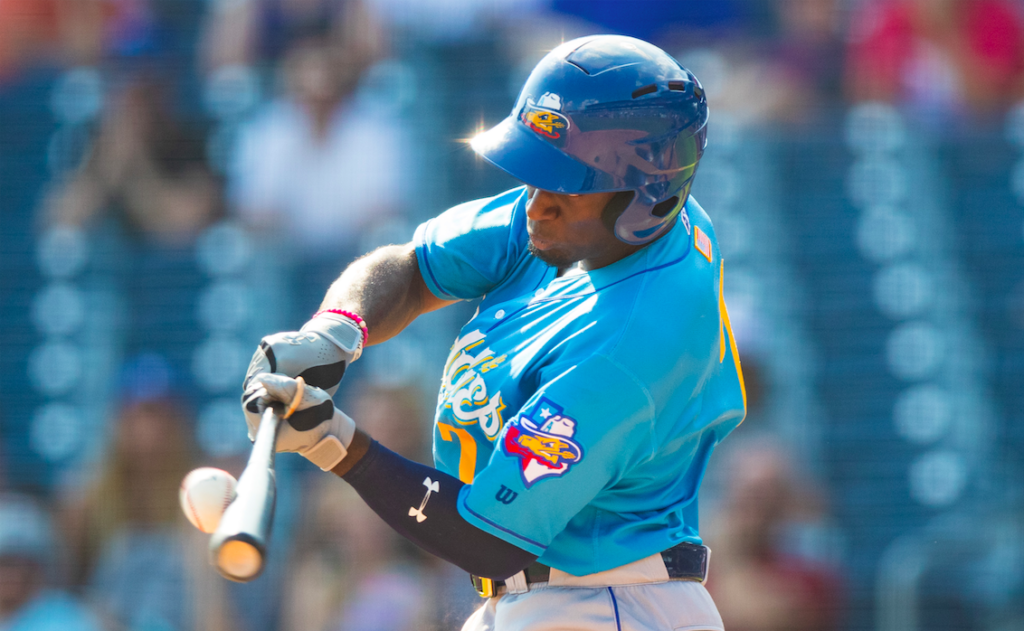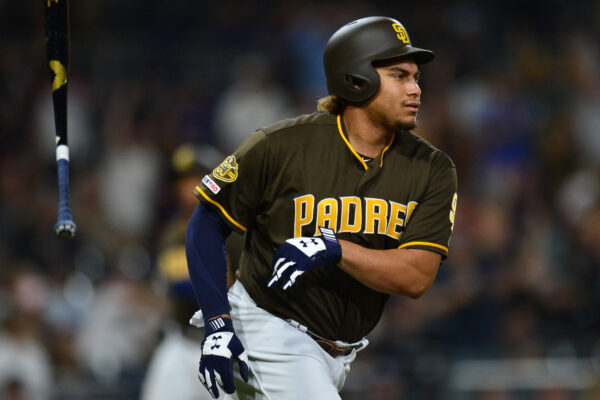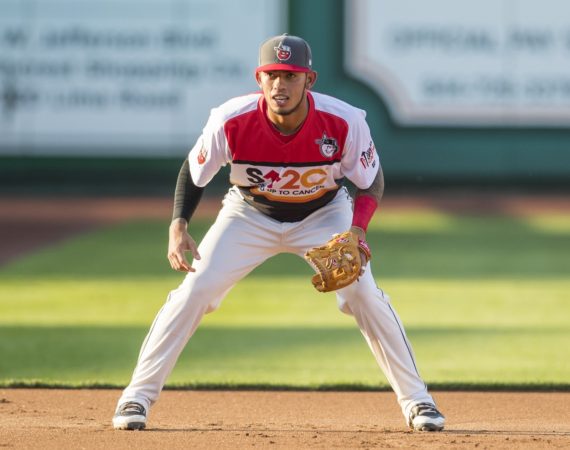A deeper look at the players traded by San Diego during a wild August

Credit: John Moore/ Sod Poodles

Remember Andrew Cashner? Remember the botched trade in 2015 with the Miami Marlins that saw Colin Rea getting sent back to San Diego after Preller withheld medical documents? Naylor was part of the trade package that the Padres were allowed to keep.
The Canadian slugger made his debut in The Show after pillaging the Pacific Coast League with the El Paso Chihuahuas. The burly outfielder brought a fiery attitude and raw power at the cost of his poor fielding.
As an outfielder in 2019, Naylor posted a -4 DRS, -4.0 UZR, and -0.9 RngR in both corners of the grass. The arrival of the designated hitter in the National League was a blessing for Naylor, where his .154 ISO and Hard Hit % of 36.3 played much better to his strength.
His aggressive style of play also worked as a double-edged sword. While the power was there, so were the strikeouts (22.9 K%, 22.2 Whiff rate in 2019).
Cleveland will deploy him as a left fielder, as another high-powered slugger named Franmil Reyes acts as the Indians’ designated hitter.
One of the only prospects of the Josh Byrnes era to survive the Preller prospect purge of 2015, Hedges is perhaps the finest defensive catcher in all of baseball. Unfortunately, his skills with the bat lagged behind his glove.
In over 3000 innings behind the plate, Hedges posted a 56 DRS while throwing out 32 percent of base stealers. Baseball Savant rated him as the top strike-stealer in both Runs Extra Strikes (15) and Strike Rate (53.8) in 2019.
At the plate, Hedges was a completely different ballplayer. Despite displaying a surprising amount of pop, his .199/.257/.359 batting line through 1339 trips made him the weak link in a San Diego lineup growing more powerful by the day.
An inability (or perhaps unwillingness) to adapt to Major League pitching and tweak his batting stance kept Hedges stagnant at the plate. Rumors about his negative personality and getting caught at a party without wearing a mask or social distancing before the season most likely drew the ire of the front office.
When Jason Castro was acquired from the Angels, Hedges’ roster status was put in limbo. When Nola was acquired, it was all over for Hedges but the crying.
Preller’s first player selected in the first round had to fight to make it to the big leagues, as Quantrill was coming off of Tommy John surgery after being selected eighth overall from Stanford.
Drafted as a starting pitcher, Quantrill started 18 games with San Diego in 2019 but transitioned to a bullpen role after Joey Lucchesi was named the fifth starter. He flourished in his role as a multi-inning reliever, pitching to a 2.60 ERA with an 18-to-6 K-BB ratio.
Quantrill utilized a slider-sinker combo in the bullpen while decreasing the use of both his fastball and changeup. His sinker was especially nasty as opposing batters hit a mere .182 against it while Quantrill chose the pitch as his put out pitch 29.6 percent of the times.
Despite losing the starting role to Lucchesi, Quantrill usually piggybacked Lucchesi after the early innings of a game as a pseudo-starter and continued to do so after Lucchesi was sent down to the alternative training site.
Quantrill still possesses a first-round pedigree and can be controllable through 2025. Cleveland has a reputation for developing quality starters and will be looking to do the same with Quantrill.
A late-round find in the 2017 Draft, the Hawaiin born left-hander rose through the Padres farm system after being selected in the 16th round.
The ninth-overall prospect in San Diego’s farm system, according to MLB.com, Cantillo split the 2019 year with Low-A Fort Wayne and High-A Lake Elsinore.
A majority of his time was spent with the TinCaps, where he pitched 98 innings with a 1.93 ERA, 0.86 WHIP, and an astounding 128-to-27 K-BB ratio. A heavy-groundball approach (42.9 GB%) also kept his home run rate at a microscopic 0.28 HR/9.
At only 20-years-old, Cantillo is still raw with at least a couple more years of development. Right now, he projects as a back-end starter with the potential to grow into something more. Cantillo currently ranks as Cleveland’s N0.15 overall prospect.
Yet another prospect signing from the 2016-2017 international spending spree, Arias was always known for his elite defense and electric arm at the shortstop position. A sudden burst of power at Lake Elsinore, however, and Arias quickly became one of the top prospects in the farm system.
Currently, the No.5 overall prospect in Cleveland’s farm system after being ranked the No.7 overall prospect, Arias’ high power ratings (.168 ISO, 17 home runs, 13.9% HR/FB) were bundled with high strikeout ratings (128 K’s, 25% K rate). While the strikeouts and home runs went up, it came at the cost of his walk rate, dropping from 8.1% in 2019 to 3.9% in 2020.

So far, it seems the 20-year-olds Kryptonite are breaking balls outside the zone that Arias can’t lay off of. The strikeouts didn’t stop Arias from posting a .302/.339/.470 batting line and a 120 wRC+ with Lake Elsinore.
Arias was always a candidate to be dealt away with Tatis firmly entrenched as the San Diego shortstop. Now, he is blocked yet again by another highly-talented shortstop: Francisco Lindor.
Fortune favors Arias in Cleveland as Lindor has been the subject of trade talks since the offseason as Cleveland wonders to itself, “To rebuild, or not to rebuild.” With all of the tools to make an everyday shortstop, it won’t take long for Arias to earn his ticket to The Show.
The final piece of the Clevinger mega-deal, it is reported that Miller and Hedges were the two pieces that put San Diego’s offer over the top for Cleveland.
San Diego’s third-round pick from the 2018 Draft, evaluators billed Miller as a potential quick riser through the Minor Leagues due to his high floor.
Indeed, Miller tore his way through the minors. Skipping the Arizona League, Miller posted an OPS of over .800 at both Short Season Tri-City and Fort Wayne right after he was drafted.
San Diego pushed Miller to Double-A as a 22-year-old, and he responded by turning in a solid .290/.355/.430 in 507 at-bats with the Sod Poodles. While there was a small rise in his strikeout rates (13% in 2019 versus 15.4% in 2020), it was balanced out by a steady 8.2% walk rate and 13 home runs.
Miller has been tabbed as a potential regular at second base, but he still saw time at both shortstop and third base with Amarillo. His potential as a utility man got him invited to both Spring Training and the alternative training site with San Diego.
While Miller doesn’t have the highest ceiling, his high floor means that he is the closest of the three minor leaguers in the deal to make his major league debut.
I am currently attending San Diego State University while working on achieving a major in journalism. At SDSU, I write for The Daily Aztec while also hosting the sports radio show “Picked Off”, for KCR Radio. A loyal fan of San Diego sports, I hope to bring content that you will enjoy reading.
Yes, the Padres received some talent. But WOW….they gave away SOOOO much. These trades are going to pay off for years to come (for the other guys). Oliveras would be perfect right now, and many of the other guys will be great in the future. It will be fun to watch the pads in the playoffs, but at what price?
Nice article Jason. While trading so many highly ranked prospects was not ideal, we knew the trade prices would be high this deadline. I’m still not totally thrilled with everything we gave away but, talent costs talent. The current team looks well equipped to go deeper into the playoffs than originally forecast.
Overall, I’m giving AJ a B+ right now. Trade grades are always more accurate down the road. We’ll see and hope we got the better ends of all of these.
I think we traded prospects that were blocked in the big leagues or on the rule 5. Credit AJ for being creative and not letting go of the core prospects who are part of the future. I have faith in our scouts that we’ll replenish the farm.